IDEX Online Research: Jewelry Price Inflation Surges in July
August 25, 08
After pausing in June, jewelry and watch prices at the retail level took off again in July, rising by 8.1 percent over the same period a year ago. Producer prices also rose at an accelerating rate in July. Price inflation in the jewelry industry is tracking closely with core inflation in the U.S. market.
However, as we have noted in the past, inflation cannot continue to rise at the current rate and core inflation is expected to moderate. After rising sharply for many months, what is behind the sudden reversal of some commodity prices? There are two key reasons, in our opinion: 1) the U.S. dollar is rising; and, 2) the inflation cycle may be waning.
Here’s the summary of inflation at the jewelry retail and supplier level for the month of June, as expressed as a percentage change year-over-year (July 2008 versus July 2007):
- Jewelry Producer Price Index +8.9 percent
- Jewelry & Watch Consumer Price Index +8.1 percent
- Jewelry CPI +9.2 percent
- Watch CPI +1.1 percent
Despite the increase in inflation in July, we believe that we may have seen the largest price increases of the year during the first half of the year, though there continue to be cost pressures that will flow through to both suppliers and retailers in the coming months. For the moment, though, our sense is that the surging jewelry prices we saw earlier this year may moderate.
While we suggest that jewelry price inflation may “moderate” for the balance of 2008, the term is relative. We continue to predict that jewelry prices at both the wholesale and retail level will rise by about 7 percent for all of 2008. That’s an inflation pace we haven’t seen since 1990.
Further, it is important to note that jewelry unit sales are down over 3 percent for the first seven months of 2008. This is the largest decline we’ve seen this decade. But it is no surprise: jewelry sales as measured by “dollars through the cash register” are barely ahead, but jewelry price inflation has surged. The net result is that most jewelers will post modestly higher sales in 2008, but sell fewer items.
There are two key uncertainties. First, precious metals prices are no longer determined solely by supply and demand. Speculators in the financial markets add substantially to price volatility. If they believe, for example, that gold should be bought as a hedge against the falling U.S. dollar, then gold prices will shoot straight upward again. And, second, precious and semi-precious gemstone prices are rising. Polished diamond prices continue to rise at an accelerating rate, too. For example, the index for all polished diamonds surged by nearly 15 percent in July 2008 versus the same month a year ago, according to the IDEX Online polished diamond index. However, on a month-over-month basis (July 2008 versus June 2008), polished diamond prices moderated slightly.
Jewelry Producer Price Index (JPPI) +8.9 percent in July
U.S. jewelry producer prices index (JPPI) rose by 8.9 percent in July, according to the U.S. Bureau of Labor Statistics (BLS). This was the sharpest increase since March, when the JPPI rose by just over 10 percent.
While gold prices have moderated and polished diamond price increases have slowed modestly, there is still a backlog of costs in the distribution pipeline that suppliers will be passing on to their customers. Therefore, we don’t expect much moderation in inflation from current levels for the near term.
The following graph summarizes the monthly JPPI for inflation since the beginning of 2007. The percentage figures are based on year-to-year comparisons.
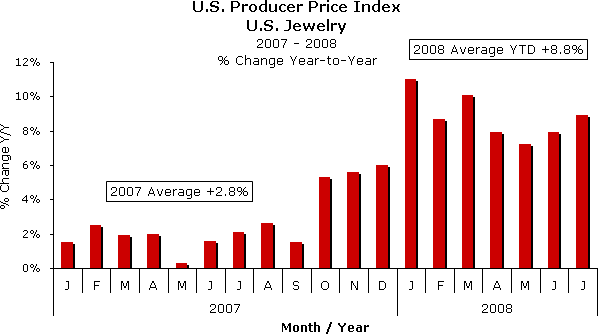
Source: BLS
What is fueling this accelerating rise in the JPPI? In prior months, it has largely been higher precious metals prices. However, in July, inflation for precious metal jewelry moderated, and showed the same increase as the entire jewelry category at the producer level. Thus, we believe that higher gemstone prices – primarily a lag effect – continue to push up jewelry prices.
The graph below compares the JPPI (red bars) to inflation for precious metals (gold bars); gold is the primary driver of precious metals inflation. We note, however, that precious metals price inflation in July was equal to inflation for the entire jewelry category at the producer level. Producer prices for “all jewelry” were up by 8.9 percent in June, the same level as precious metal jewelry inflation. Earlier this year, precious metals price inflation was 200 or more basis points greater than jewelry producer prices for all goods.
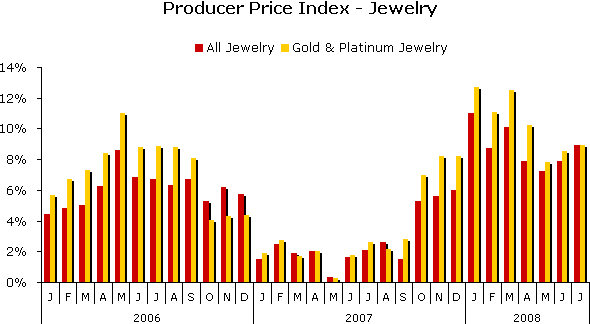
Source: BLS
Jewelry Consumer Price Index (JCPI) +8.1 percent in July
U.S. jewelry consumer prices (JCPI) rose by a sharp 8.1 percent in June, as calculated by the BLS. After rising sharply in March, April, and May, jewelry price increases at the retail level moderated in June. However, they surged again in July. For the year-to-date, retail price inflation for jewelry in the U.S. market is running at an annual rate of +6.4 percent.
We believe that jewelry retail prices rose sharply early in the year as retailers repriced goods to reflect the pent-up inflation that was flowing through from the supplier level. Zale, Sterling (Kay) and others announced they were going to raise prices. As a result, most independent specialty jewelers also implemented price increases.
We think that June’s retail price inflation pause was either a statistical aberration or a momentary pause in inflation. Either way, jewelers have continued to raise their prices in the face of sharply rising costs, as shown by the July figures.
The graph below summarizes the percentage change in retail prices of jewelry and watches by month on a year-to-year basis since 2007 (July 2008 versus July 2007).
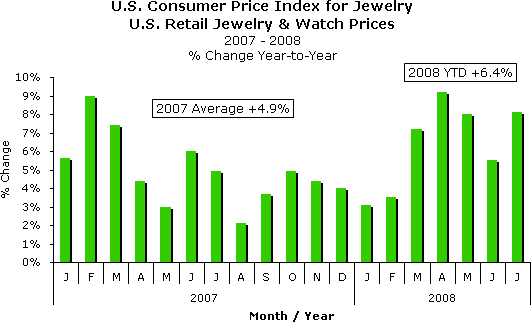 Source: BLS |
The components of jewelry and watch price inflation at the retail level reflect a dichotomy in price increases. Jewelry retail prices have been up consistently during the first half of 2008, but watch retail prices have been down consistently – every month – for the first half of the year, though they showed a slight increase for July.
We are a bit surprised that watch price inflation has lagged. Why? There are two key reasons: 1) watch mechanisms from Switzerland have been in short supply due to manufacturing capacity constraints; and 2) demand for high-end watches and branded watches has been strong, according to retail jewelers. However, because of the consistency of the BLS inflation numbers, we are inclined to believe that watch prices were down at retail, at least during the first half of the year.
The graph below illustrates the JPPI consisting of both jewelry and watch prices (green bars), jewelry prices only (red bars), and watch prices (yellow bars).
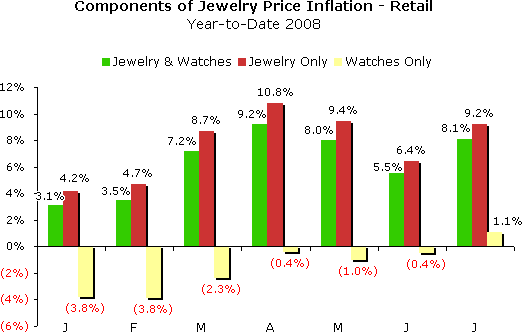 Source: BLS |
Jewelry Unit Sales Down in 2008
Most U.S. jewelers can expect to sell fewer items this year, but they are likely to see more dollars flow through their cash tills. So far this year, jewelry sales are ahead by about 3.1 percent, a rate that is decelerating. However, year-to-date jewelry price inflation is running at 6.4 percent, a rate that is currently accelerating. Thus, unit sales are down by 3.3 percent.
The table below summarizes jewelry sales, the JCPI, and unit sales of jewelry since 2000. Unit sales are down by a greater level in 2008 than at any time in this decade.
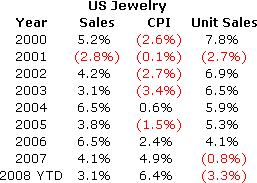
Source: IDEX Online & BLS
Outlook: Above-Average Price Inflation Expected to Continue
Our forecast calls for both jewelry consumer prices and jewelry producer prices to rise by about 7 percent in 2008. We’re going to stay with those forecasts, though if we were to “fine tune” them today, we might reduce the jewelry consumer price index forecast to +6 percent or so, but we might be tempted to raise the jewelry producer price index forecast to +8 percent or so. For sure, prices are headed higher as suppliers and retailers continue to attempt to recoup large costs increases which have hit the industry over the past three years or so.